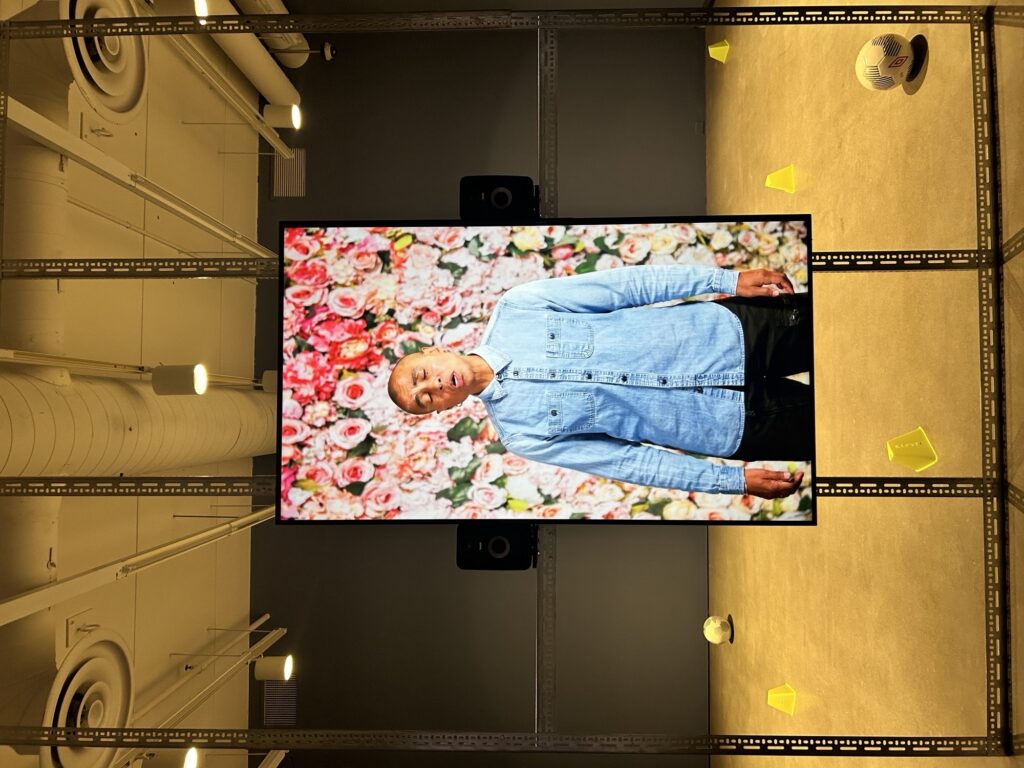
On March 11, 2023, Museum Queeries members visited Plug In Institute of Contemporary Art to see Quantum Choir by Michèle Pearson Clarke and also attended an artist talk at Club 200 featuring Clarke and Alanna Fields. See the following SnapThoughts to learn more about Museum Queeries members’ thoughts and impressions about the exhibit and talk.
For more information about the exhibit, click here.
Quantum Choir by Michele Pearson Clark is a moving exploration of queer female masculinity. The chorus of voices and the visual dimension of the four screens present challenges to the spectator, whose attention is constantly moving from screen to screen and speaker to speaker. How does one decide who to watch? Who to listen to? At first I tried listening to all the voices and viewing all the screens simultaneously but eventually settled into a less frantic viewing in which I focused my attention on one screen for a period of time, and then another, and then another. The artist and the three participants seemed intimately familiar to me, even though I had never met any of them. I think this speaks to the role queer female masculinity has played in my own life as most of my lovers and many of my friends have been masculine queer women. For this reason, the vulnerability of these four singers, and also the way their voices, their embodiment, and their gender presentation were honoured in Quantum Choir, resonated with me on an affective level. – Heather Milne
Quantum Choir by Michèle Pearson Clarke is an exhibition that goes beyond the expectations that I had of what could be done when collaborating with others. The four-channel installation work, with the screens all facing one another, brings the viewer face to face with each of the subjects that are singing. I think the intimacy of standing within the piece, which is so different from being outside of it, can make people think critically about vulnerability in a gallery space. The four butch women are all singing, some visibly nervous, laughing and, in the case of Michèle at the end, crying. They all are able to show vulnerability, although Michele is the one coordinating it all—a seemingly external position—she is also able to bring parts of herself into the work. To be able to see butch women being in a space like Plug In is a rare experience because of the lack representation of butch women in art spaces. Quantum Choir made me think more critically about the various queer people that take up space in gallery and museum spaces, prompting the question for me of who is allowed to exist within those “four white walls.” – Mahlet Cuff
I loved Clarke’s Quantum Choir. The exhibit invites the viewer into a circle of sound featuring beautiful, life-sized video projections of queer masculine women singing. I keep thinking about how the singers’ voices were sometimes in unison, sometimes solo, and that although recorded separately, they were layered in a way that connected them while maintaining their individuality. The projections and voices came in and out of the visual and audible field, as if the singers were passing a soccer ball to each other around the circle, holding the game/song in play together (Clarke explained that she knew the singers from having played in soccer leagues with them, also represented by soccer balls and pylons staggered around the gallery space surrounding the video/sound installation). I felt kept in company by this gentle and moving work, and appreciated Clarke’s clever nod to the queer euphemism of being “on the team.” – Angela Failler
While I was not present for Michèle Pearson Clarke’s tour of her solo exhibition at Plug In ICA, titled Quantum Choir, I had the great pleasure of attending her artist talk alongside photo artist, Alanna Fields. The event was not held at the gallery space but, rather, it was hosted by Winnipeg’s oldest queer bar, Club 200. Both Clarke and Fields engage with Black, queer experiences using digital image-making and archival expressions within their artist practices and, therefore, the location made sense. Rows of chairs were placed on the dance floor as reflective multicoloured streamers fluttered in sync with the heating system—we were undeniably in a queer club, invoking an intimate setting that sparked meaningful discussions led by the artists. Using PowerPoint slides and a touch of queer humour, Clarke and Fields delved into their processes, concepts, and outcomes while centring the importance of community. This felt especially apt, not only because of the location, but also the participants, who remained captivated by their dynamic and expanding artist practices. – Adrienne Huard
